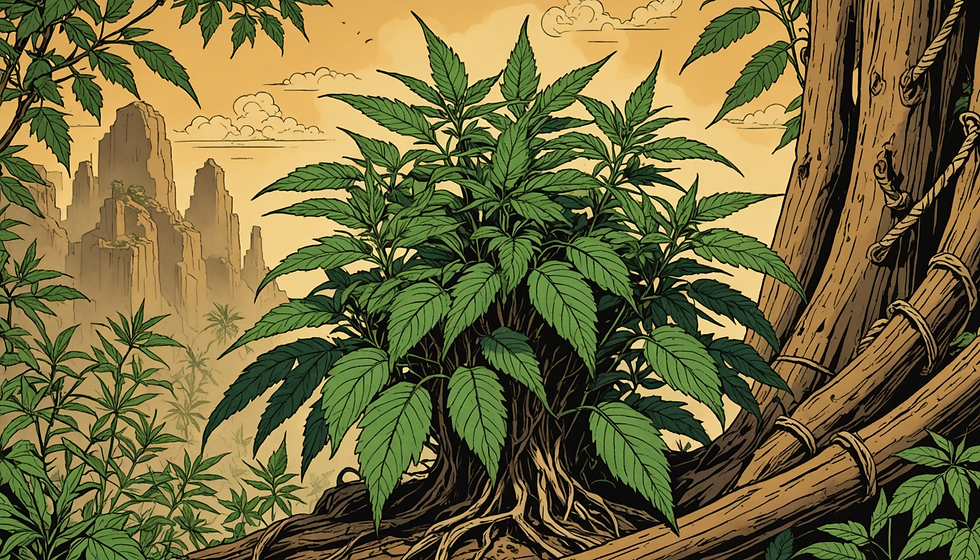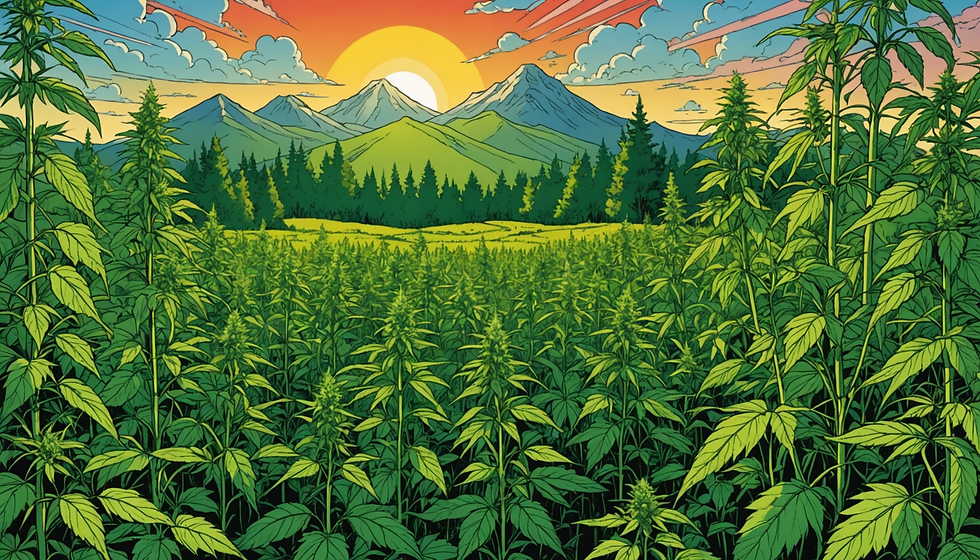Hemp's Journey: From Ancient Origins to Modern Applications
- The Lifted Leaf
- Jan 12
- 4 min read
Updated: Jan 27

Introduction: Nature's Swiss Army Knife
Hemp is not just any plant; it’s a remarkable tool crafted by nature, woven into the fabric of human history for millennia. With its sturdy fibers, nutrient-rich seeds, and promising medicinal applications, hemp embodies versatility and sustainability. As we embrace a more eco-conscious world, this resilient plant is stepping back into the limelight, prepared to transform various industries, including fashion, food, construction, and medicine.
Hemp as a Plant: The "Chill" Cousin of Cannabis
While hemp and marijuana both belong to the Cannabis sativa family, they have distinct characteristics. Hemp is the responsible, calm cousin—boasting insignificant traces of THC, the psychoactive compound responsible for the "high" associated with marijuana (National Institute on Drug Abuse, 2020). Think of hemp as the steady friend you can rely on, celebrated for its strong fibers and nutritional seeds, and cherished for its wide array of industrial uses.

History of Hemp: From Ancient Roots to Modern Revival
The legacy of hemp stretches back to the dawn of civilization. Some archaeological evidence suggests that hemp was cultivated in China around 6,000 BC—predating even the Great Pyramids (Li et al., 2006). The plant spread its influence across Europe and beyond, becoming integral to producing ropes, textiles, paper, and even medicinal products. Fun fact: the very first American flag was crafted from hemp fibers, underscoring its historical significance (Washington, 2019).

Hemp in the United States: A Founding Father's Favorite
In early America, hemp was an agricultural superstar, so valuable that it served as currency in some colonies (Smith, 2017). Founding Fathers including George Washington and Thomas Jefferson were avid hemp cultivators (Carpenter, 2016). However, the landscape shifted dramatically with the Marihuana Tax Act of 1937 and the Controlled Substances Act of 1970, which effectively banned hemp due to its association with marijuana (Carpenter, 2018). Thankfully, the tides turned with the passage of the 2018 Farm Bill, which once again recognized hemp’s tremendous potential and reinstated its legality (United States Congress, 2018).

The Hemp Renaissance: Sustainability Meets Innovation
Hemp's eco-friendly cred and versatility have sparked a modern renaissance. Hemp fiber is strong, durable, and biodegradable – a triple threat against resource depletion, making it a superhero compared to synthetic fibers and other resource-intensive materials (B2B Hemp, 2021). It can be turned into textiles, paper, building materials, bioplastics, and biofuels. Hemp is rich in protein, omega-3 fatty acids, and other beneficial nutrients, and can be eaten as hemp hearts, hemp oil, hemp milk, and so much more (Hemp Industries Association, 2020). By replacing or enhancing existing materials and products, hemp is paving the way for a sustainable future!

The Future of Hemp: A Green Revolution
Hemp is more than just a trend; it represents a green revolution set to reshape industries ranging from fashion and food to construction and medicine (Thompson, 2022). Picture a world where your wardrobe is crafted from hemp, your vehicle runs on hemp biofuel, and healthcare includes hemp-based treatments. This isn’t merely wishful thinking—it’s a tangible reality that’s emerging more rapidly than ever.
As global awareness of hemp's benefits continues to rise, it is taking center stage across various sectors. The fashion industry is moving away from cotton and synthetic materials in favor of sustainable hemp options. The food industry is embracing the nutritional value of hemp seeds and derived products. In construction, hemp is emerging as a preferred building material. And the medical field is exploring the therapeutic potential of hemp, including a diverse range of powerful cannabinoids (Johnson, 2021). Together, hemp’s versatility and sustainable attributes are guiding us towards a greener, more environmentally conscious world.
Join us in celebrating hemp's remarkable journey as it unlocks its potential, blending history, sustainability, and innovation to create a greener future!

References
B2B Hemp. (2021). The economic advantages of using hemp over synthetic fibers.
Carpenter, J. (2016). Marijuana and the Founding Fathers. Journal of the American Revolution.
Carpenter, J. (2018). The impact of the Controlled Substances Act on hemp cultivation in the United States. Journal of Agricultural History, 92(3), 345-367.
Hemp Industries Association. (2020). The nutritional profile of hemp seeds.
Johnson, A. (2021). Exploring the therapeutic benefits of hemp-derived health products. Journal of Medicinal Plants Research, 15(4), 56-71.
Li, H., Zheng, Y., & Wang, Y. (2006). Archaeobotanical evidence of hemp (Cannabis sativa L.) in ancient China. Economic Botany, 60(2), 195-200.
Smith, T. (2017). Hemp: American History Revisited: (How Growing Our Own Food Can Change the World). CreateSpace Independent Publishing Platform.
Thompson, M. (2022). Hemp: The key to a sustainable future? Sustainable Living Journal, 10(1), 23-35.
United States Congress. (2018). Agriculture Improvement Act of 2018. Retrieved from https://www.congress.gov/bill/115th-congress/house-bill/2/text.
Washington, G. (2019). Hemp and the early American agricultural economy. Historical Journal of Agriculture, 45(2), 123-135.




